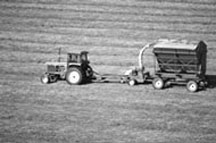| |
| Youth who reside and work on farms are exposed to potentially
dangerous farm hazards more frequently than other youth. Understanding
how to create a safe farm environment is important for farm operators
and their families. |
Content
Youth on Minority Farm Operations
- Agriculture continues to rank as one of the most hazardous industries
- Youth are exposed to hazards while living, working on, or visiting
farms
- In 2000, there were approximately 47,700 farms operated by minorities
in the United States, with an estimated 28,600 youth living in these
farm households
- Between 1995 and 2000, the injury fatality rate for youth on minority
farm operations was 34 fatalities per 100,000 youth
- In 2000, the non-fatal injury rate for all youth who reside on, work
on, or visit minority farm operations was 130 injuries per 100,000 youth
on the farm
Household Youth on Minority Farm Operations, 2000
Household youth comprise all youth 0-19 years of age who reside on minority
farm operations and include working and non-working youth
- An estimated 28,600 household youth lived on minority farm operations:
348 were injured (12 injuries per 1,000 household youth)
- 10-15 year olds had the highest injury rate (15 injuries per 1,000
household youth)
- 138 injuries occurred while working on the farm (3 injuries per 1,000
household youth)
- 10-15 year olds experienced the highest rate of injury while doing
farm work (13 injuries per 1,000 household youth)
Non-Fatal Injuries: Household Youth on Minority
Farm Operations, 2000
The most common sources for the 348 non-fatal injuries to household youth
on minority farm operations were:
- Floors, walkways, ground (34%)
- Vehicles (14%)
- Person, animals, plants, minerals (12%)
The most common types of injury were:
- Cut, laceration (27%)
- Broken bone, fracture (23%)
- Bruise, contusion (14%)
The body parts most commonly injured were:
- Arm (17%)
- Leg (16%)
- Hand, wrist, fingers (14%)
Fatal Injuries Among Youth on Minority Farm Operations,
1995-2000
- The majority of deaths to youth on minority farm operations were due
to drowning (37%) and machinery (10%)
- An estimated 59 youth died on minority farm operations in the United
States and most fatalities occurred to youth 16-19 years of age
Farm Youth Safety Recommendations
Remember to...
- Inspect your farm for potential hazards to children
- Provide young children a safe play area away from hazards such as
livestock, structures, farm machinery and vehicles
- Make sure that farm chores assigned to youth are appropriate for their
age
- Be a good role model for farm safety
- Consider outside childcare during busy farm seasons
- Make sure all dangerous areas are clearly marked with hazard signs
- Keep toxic substances in their original containers and lock them up
safely
- Devote a day to FARM SAFETY instructions and rules
Safety Tips about Youth and Machines
- Follow the “one seat—one rider” rule. Do not allow
extra riders on tractors, all terrain vehicles (ATVs) and other farm
equipment
- Follow manufacturers’ recommendations for age restrictions when
operating machinery and equipment (e.g., most manufacturers and safety
experts recommend that youth less than 16 not operate ATVs or machinery
unless they have received formal training and are closely supervised)
- Once youth reach an appropriate age, teach them how to operate ATVs
and machinery properly. Encourage youth to take safety training courses.
- Leave buckets or forks on loaders and tractors in the down position
when not in use
- Keep vehicles and machinery properly maintained at all times
- When parked, self-propelled machinery should be locked and keys removed
from the ignition
Safety Tips about Youth and Animals
- Teach youth how to handle and work with animals safely
- Make sure children have no contact with farm animals that are aggressive,
sick, are mothers of newborns, or breeding male animals (bulls, boars,
rams, etc.)
- Make sure children wear proper protective clothing when handling animals
- Provide shots and proper health checks for all household pets
Safety Tips about Youth and Water
- Children should always be supervised when playing in or near water
- Restrict entrance to ponds, lagoons, pools, manure pits, etc.; fence
these areas if possible
- Empty or cover containers with standing water in areas where toddlers
are present
- Make sure wells are securely closed, or filled if no longer in use
- Install water safety and rescue equipment at all farm ponds
- Teach children to swim at an early age
- Be aware that alcohol can contribute to teen drownings on farms
Need More Information?
National Children’s Center for Rural and Agricultural Safety
and Health
1000 North Oak Avenue
Marshfield, Wisconsin 54449
Telephone: 1-888-924-SAFE (7233)
http://research.marshfieldclinic.org/children
North American Guidelines for Children’s Agricultural Tasks (NAGCAT)
Telephone: 1-888-924-SAFE (7233)
http://www.nagcat.org
Farm Safety 4 Just Kids
P.O. Box 458
Earlham, Iowa 50072
Telephone: 1-800-423-5437; 515-758-2827
http://www.fs4jk.org
INSURE KIDS NOW!
Your state, and every state in the nation, has a health insurance program
for infants, children, and teens. The insurance is available to children
in working families. To learn more, make a free call to find your State’s
Program.
Children’s Health Insurance Program (CHIP)
U.S. Department of Health & Human Services
Telephone: 1-877-KIDS-NOW (1-877-543-7669)
http://www.insurekidsnow.gov
Copies of other NIOSH documents on occupational safety and health are
available from:
National Institute for Occupational Safety and Health
Education and Information Division (EID)
4676 Columbia Parkway M/S C-13
Cincinnati, Ohio 45226-1998
Telephone: (800) 35-NIOSH [(800-356-4674)]
Fax: (513) 533-8573
DHHS (NIOSH) Publication Number 2004-117
December 2003
Injuries to Youth on Minority Farm Operations
Visit the NIOSH Web site at: http://www.cdc.gov/niosh
Centers for Disease Control and Prevention
National Institute for Occupational Safety and Health
|
| 
 This
document is also available in PDF format. This
document is also available in PDF format.
2004-117.pdf
2 pages, 466kb

|
|



